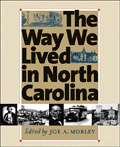


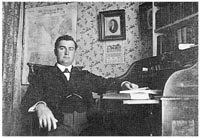
Mordecai Ham
|
THE DESERT BLOOMS . . .
CHAPTER EXCERPTS
"Evilution"
 he year 1920 saw North Carolina reeling dolefully toward a dreaded showdown between conflicting factions of its cultural and intellectual leadership. A small but earnest and vocal element was concerned about the threat to traditional values posed by the whirlwind of new ideas and gadgets of the past generation or so. Another group, similarly articulate and committed, conceived of itself as precursors of a bright new world that would be safe for novel gadgets and ideas. By 1920 it was becoming clear that the two groups had settled upon evolutionary science as the central issue over which they would first test their relative strength. Evolutionary theory was based on the conclusions of nineteenth-century English naturalist Charles Darwin. According to Darwin, the origin and development of human beings, animals, and plants could be explained according to the concept of natural selection. To many religious fundamentalists, such an idea denied the biblical interpretation that man was created by God. he year 1920 saw North Carolina reeling dolefully toward a dreaded showdown between conflicting factions of its cultural and intellectual leadership. A small but earnest and vocal element was concerned about the threat to traditional values posed by the whirlwind of new ideas and gadgets of the past generation or so. Another group, similarly articulate and committed, conceived of itself as precursors of a bright new world that would be safe for novel gadgets and ideas. By 1920 it was becoming clear that the two groups had settled upon evolutionary science as the central issue over which they would first test their relative strength. Evolutionary theory was based on the conclusions of nineteenth-century English naturalist Charles Darwin. According to Darwin, the origin and development of human beings, animals, and plants could be explained according to the concept of natural selection. To many religious fundamentalists, such an idea denied the biblical interpretation that man was created by God.
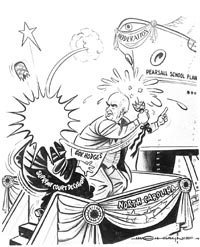
Governor Luther Hodges's Pearsall Plan, 1955, attempted to thwart meaningful school desegregation. Cartoon by Hugh Haynie, Greensboro Daily News.
|
Evolution was wonderfully designed to crystallize a thousand differences on other matters. Bewitchingly inviting to the rationalist mentality, it seemed from the perspective of the biblical literalists a thing of sin and sacrilege. Those who favored the Darwinian theory also were perceived by their critics as tolerant of socialism and unionism, permissive toward sexual behavior, sympathetic to the rights of women and minorities, and so on. Those arrayed against Darwinism tended to oppose these and related views. The first group was called "liberal," the second "conservative." Most Tar Heels were not strictly identifiable with either group, but the tug of centuries of sentiment drew them more toward the latter.
In North Carolina the issue between the two groups reached a crisis in the mid-1920s. Focal points in the ensuing struggle included W. O. Saunders's furious combat against evangelist Mordecai Ham in Elizabeth City in the fall of 1924 and an effort by fundamentalists to oust from office Dr. William L. Poteat, proevolutionist president of Wake Forest College, the state's leading Baptist school.
The fragility of the liberal position was made manifest in 1950 with the defeat of Frank Porter Graham, moderately liberal president of the University of North Carolina, in his bid for nomination by the Democratic Party as its candidate for the United States Senate.

Still another round in the running dispute occurred in 1963 over the "Speaker-Ban Law." Alarmed by noisy student civil rights demonstrations in Greensboro, Chapel Hill, and elsewhere, conservative legislators drafted a bill to impose restrictions on visiting speakers who made use of state property. Passage of the act raised a pained outcry from the academic community, then far more populous than in the 1920s. Anxious to find a peaceful resolution, Governor Dan Moore appointed a study commission, which recommended certain modifications of the law. Authority over visiting speakers was ultimately returned to the state campuses, but it required an order of a federal district court to abrogate the Speaker-Ban Law as unconstitutional.
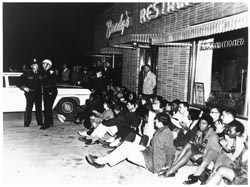
Students protest segregation at a sit-in at Brady's Restaurant in Chapel Hill, 1964.
|
Lunch at Woolworth's — Black frustration over the state's foot-dragging on desegregation was one of the factors behind the protest movement that began in Greensboro on 1 February 1960. On that day, four students from all-black North Carolina Agricultural and Technical (A&T) College sat down at a lunch counter in the Woolworth's department store and asked for service. Refused on the ground that local custom forbade it, the students occupied their seats until closing time and returned the next day with reinforcements. In subsequent days they were joined by others, including a few white students. When the Woolworth counter was fully occupied by protesters, others moved on the S. H. Kress store down the street.
Sit-ins had occurred at other places throughout the country in earlier years, but those in Greensboro became the impetus for social revolution. A week later they had spread to Winston-Salem and Durham, the seats of other black colleges. Within two weeks they were occurring in other states and touching off sympathetic demonstrations in the North. When the Woolworth, Kress, and Myers stores in Greensboro relented in July and allowed blacks to eat at their lunch counters, it seemed that the seas had parted at last for the black community. The commotion had called forth another resurgence of the Ku Klux Klan (as well as leading to the Speaker Ban), but it had also produced a dynamic and charismatic new black leader, A&T College football star Jesse Jackson.

The Voting Rights Act of 1965 empowered the federal government to bring legal action against local election boards that attempted to prevent African Americans from legally registering and voting. That act restored the right to vote that had been denied to the majority of African Americans in North Carolina from the time they were disfranchised in the white supremacy election of 1900. The state's African Americans immediately exercised their newly won political power. In 1968, they elected Henry E. Frye of Guilford County to the General Assembly. He was the first African American to serve in the legislature in more than seven decades. In 1974, Frederick Douglas Alexander of Mecklenburg County and John W. Winters of Wake County were elected to the state Senate and House respectively. From 1970 to 1997, 506 black North Carolinians served in political offices. Among them were members of Congress: Eva Clayton of the First District and Mel Watt of the Twelfth District. In that same period, more than sixty African Americans served in the General Assembly, and 354 served in city and county governments. In 1983, Governor James B. Hunt Jr. appointed Henry Frye to the state supreme court. Frye won statewide election as an associate justice in 1984 and 1992, and he became chief justice in 1999. Dan Blue of Wake County presided as Speaker of the North Carolina House of Representatives from 1991 to 1994, and Ralph Campbell Jr. served as state auditor in 1992 and 1996. During the 1980s and 1990s, a number of black North Carolinians served in state positions under both Democratic and Republican administrations.

The Rebel Rib — The decade of the 1920s opened with the Nineteenth Amendment on the verge of adoption and North Carolina in a position to be the state that guaranteed the enfranchisement of women. The North Carolina Federation of Women's Clubs became an active leader in the effort to secure the vote for women. But, amid warnings that "politics are bad for women and women for politics," the state legislature rejected the amendment, and it remained for Tennessee on the next day to provide the last vote needed for ratification, thereby bestowing the franchise on American women.
Equality of status, nevertheless, continued to elude the Tar Heel woman throughout the next fifty years; only after World War II would she gain the right to sue and recover for personal injuries, to keep her earnings and property separate from her husband's, and to dispose of her real property without her husband's consent. Even then, there remained numerous realms in which women were accorded inferior legal status.
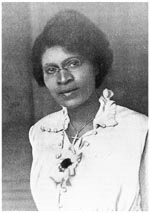
Charlotte Hawkins Brown
|
Role models for the emancipated generation of women were provided by a small number of female doctors, lawyers, nurses, suffragettes, and others. A notable standard of achievement in this era was the career of Charlotte Hawkins Brown, a Vance County native. The daughter of former slaves, Brown was educated at Wellesley College, in Massachusetts, and returned to North Carolina in 1902 with a missionary zeal to devote her life to the improvement of the lives of black people. At Sedalia, in Guilford County, she founded Palmer Memorial Institute, which gradually gained strength and recognition as a private elementary and high school for black children.
Susie Marshall Sharp, a Reidsville lawyer, enjoyed the distinction of serving as a justice on the North Carolina Supreme Court at a time when few women obtained law degrees. A graduate of the University of North Carolina law school and editor there of its law review, she became the first woman appointed judge of the Superior Court. In 1974 she was elected chief justice of the state supreme court by the largest majority on the Democratic ticket, the first woman in the state's history to attain so high a judicial position.

Fields of Glory — An intriguing example of the vitality of rural culture was the half-century's religious experience. North Carolina in colonial times had been widely considered lost and perhaps unredeemable. But the Great Revival at the opening of the nineteenth century welded the people of the state firmly into the Bible Belt. Church membership outstripped population growth. By 1926 the state's sixty-seven religious denominations enrolled half of all North Carolinians. The huge majority of church members were Protestant, and the greatest proportion of these were Baptists, with Methodists and Presbyterians trailing well behind. Overwhelmingly, the churches of the 1920s were small rural affairs averaging about a hundred members each.

The wedding of rural evangelicalism with urban electronic media produced spectacular results. Instead of being tamed into urbane blandness, the evangelicals found vast new audiences for their appeals. The obstacles of poor roads and isolated congregations overcome by technology, the best evangelistic preachers became extraordinarily effective radio and TV sermonizers. A prodigy of the new mass-appeal approach was Charlotte's William Franklin ("Billy") Graham.
If the new evangelicals made a marked impression on personal morality among Tar Heels, they did not retard the exuberant flowering of popular recreation and entertainment. The filling of leisure time with suitable activities and spectacles became the basis of a number of major industries in North Carolina. Easily the most successful of these in the middle decades of the century were spectator sports.
Big-time football was the earliest of the era's athletic spectacles. By the 1920s the larger colleges had developed keen rivalries in various sports, but the people's choice was clearly the fast and rugged action of the gridiron. A contest between the universities of North Carolina and Virginia was, besides, a chance to even the score against generations of Old Dominion "witlings," as the state song phrased it, who had "defamed" and "sneered at" their less fortunate neighbors. But it was the Wallace Wade powerhouses at Duke in the 1930s and 1940s that brought national attention to North Carolina and gave football firm claim to center stage.
Football lost some measure of its prominence after World War II when North Carolina State College (now North Carolina State University) hired for its new basketball coach a high school coach from Indiana named Everett Case.
Outside the college area, the sports phenomenon of the post-World War II epoch in North Carolina is unquestionably stock-car racing. The sport originated in the 1930s among groups of bootleg-runners and shade-tree mechanics and developed rapidly after the war. By 1949, when Grand National racing with late-model cars began at the Charlotte Motor Speedway, stock cars were a regional addition. The thrill of high speeds and flaming crashes led to such institutionalized tireburners as the Charlotte 600 and National 500, both of which began in 1960. Within a few years, the North Carolina Motor Speedway at Rockingham added the Carolina 500 and the American 500 to the Grand National tour. But there were many smaller tracks all over the state.

Commercial radio broadcasting began in North Carolina in 1922, when a license was issued to station WBT in Charlotte. Earle Cluck, one of the organizers of the station, had earlier operated an experimental station from a private home in Charlotte, transmitting from an abandoned chicken house. The chief innovator among the stations, however, was the next one established—WPTF in Raleigh. WPTF won renown for its "firsts" in Tar Heel broadcasting, including football and basketball games, live broadcasts from the state fair, and a regularly scheduled farm program. By 1971 there were 231 commercial and noncommercial radio stations operating in the state, an increase of about 25 percent over the previous decade.
The era of commercial television in North Carolina was inaugurated in July 1949 by WBTV in Charlotte, followed within weeks by WFMY in Greensboro. Within three decades, more than 90 percent of the homes in the state had TV sets, and there were fifteen commercial and three educational stations. The North Carolina Association of Broadcasters was the fifth largest such organization in the country, and the influence of the television medium was attested to in 1972 when the Tar Heel TV commentator Jesse Helms won election to the United States Senate.
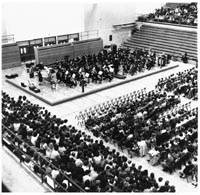
The North Carolina Symphony in concert.
|
Laurels at Last — The North Carolina Art Society, recipient after 1929 of limited public funds, established a small museum in a room at the State Agricultural Building—but painting was the exotic interest of the few as the decade of the 1950s began. As president of the North Carolina Art Society, Katherine Clark Pendleton Arrington was an important force in the establishment and operation of the Mint Museum of Art and the North Carolina Museum of Art.
State funds also gave impetus to the North Carolina Symphony, which was founded in 1933 as the first state symphony in the nation.
The Social Organism — Implicit in the transformation of cultural life in North Carolina was a recognition that it was not enough for Tar Heels to come to terms with the rest of the region, the nation, the world. They must also come to terms with each other. No age demanded this recognition more insistently.
The pressure for minority rights for blacks, women, children, gays and lesbians, the aged, and the poor were so many reminders of an ancient but evidently doomed social and sexual hierarchy. Conceivably, some new hierarchy was emerging to replace it. But hierarchy itself was in ill-repute. The American Indian rejected ascriptions of inferiority. The many Latinos migrating into the state from Mexico seeking work in agriculture and industry added their labor and elements of their culture and language to everyday life in the Tar Heel State. By the year 2000, Hispanics comprised 5 percent of the state's population. Advocates of migrant laborers appeared in North Carolina courtrooms and social programs. The handicapped won recognition of their right to ramps and other special facilities in public places. North Carolina discovered that it had not one or two minority groups but scores, that all of us belonged to one such group or another.
Self-recognition and sometimes strident self-assertion by subgroups appeared to be a new and permanent component of social and cultural relations. From every quarter arose the demand that respect be accorded on equal terms to all groups and, ultimately, to every individual. There might remain ways of circumventing the demand; there seemed to be no prospect of squelching it. To be a Tar Heel was no longer to be white, male, adult, and middle-class only; the term now had wider meaning and content, a new promise for all North Carolinians of the spiritual and material benefits of the good life.
|

